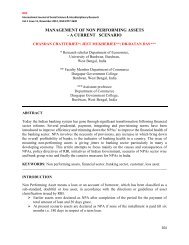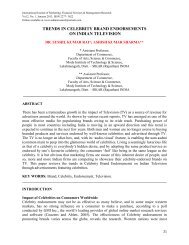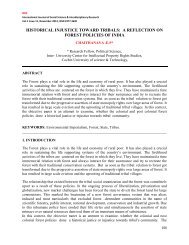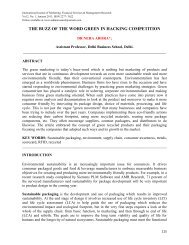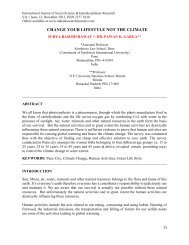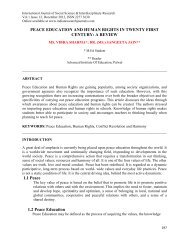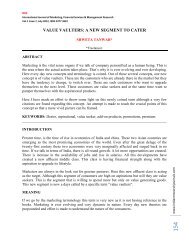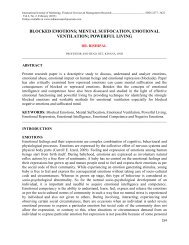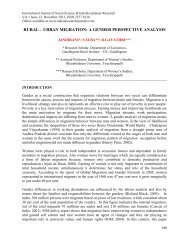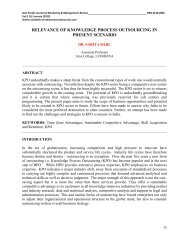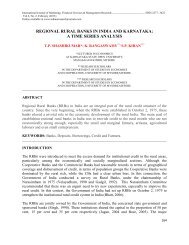teacher motivation and quality education delivery: a study of public ...
teacher motivation and quality education delivery: a study of public ...
teacher motivation and quality education delivery: a study of public ...
Create successful ePaper yourself
Turn your PDF publications into a flip-book with our unique Google optimized e-Paper software.
International Journal <strong>of</strong> Social Science & Interdisciplinary Research<br />
Vol.1 Issue 12, December 2012, ISSN 2277 3630<br />
Online available at www.indianresearchjournals.com<br />
UNESCO as cited in Education for All (EFA) (2005) identified social change, the notion <strong>of</strong> lifelong<br />
learning, relevance, <strong>and</strong> emphasis on science <strong>and</strong> technology as factors to improve the<br />
<strong>quality</strong> <strong>of</strong> <strong>education</strong>. UNICEF emphasizes five desirable dimensions <strong>of</strong> <strong>quality</strong> <strong>education</strong>:<br />
“learners, environment, content, processes, <strong>and</strong> outcomes that are founded on the rights <strong>of</strong> the<br />
whole child <strong>and</strong> all children to survival, protection, development, <strong>and</strong> participation (UNICEF,<br />
2000 cited in Ankomah et al (2005)”. In 1990 the World Declaration on Education for All<br />
(EFA), identified <strong>quality</strong> as a prerequisite for achieving the fundamental goal <strong>of</strong> equity. While<br />
the notion <strong>of</strong> <strong>quality</strong> was not fully developed, it was recognized that exp<strong>and</strong>ing access alone<br />
would be insufficient for <strong>education</strong> to contribute fully to the development <strong>of</strong> the individual <strong>and</strong><br />
society. Emphasis was accordingly placed on assuring an increase in children‟s cognitive<br />
development by improving the <strong>quality</strong> <strong>of</strong> their <strong>education</strong>. The conference recommended that the<br />
cognitive development <strong>of</strong> children should be emphasized as an indicator <strong>of</strong> <strong>quality</strong> <strong>education</strong>.<br />
The Millennium Conference (the 2000 Dakar Framework for Action) exp<strong>and</strong>ed the definition <strong>of</strong><br />
<strong>quality</strong> to include the desirable characteristics <strong>of</strong> learners (healthy, motivated students),<br />
processes (competent <strong>teacher</strong>s using active pedagogies), content (relevant curricula) <strong>and</strong> systems<br />
(good governance <strong>and</strong> equitable resource allocation). (Dakar Framework for Action, 2000 cited<br />
in Ankomah et al, 2005).<br />
Etsey (2004) cited in Ankomah et al (2005) showed that the <strong>quality</strong> <strong>of</strong> basic <strong>education</strong> is low in<br />
Ghana despite funding by international donors <strong>and</strong> different interventions to improve the <strong>quality</strong><br />
<strong>of</strong> basic <strong>public</strong> <strong>education</strong>. According to Kraft (1995) cited in Ankomah et al (2005) there is a<br />
dramatic difference between the <strong>education</strong>al opportunities available to children in rural settings<br />
<strong>and</strong> those who attend school in towns, regional centers <strong>and</strong> the national capital. Also, there is<br />
overwhelming geographical disparity between the southern, central, <strong>and</strong> northern zones <strong>of</strong> Ghana<br />
in every aspect <strong>of</strong> schooling. A <strong>study</strong> <strong>of</strong> private schools in Ghana by the Educational Assessment<br />
<strong>and</strong> Research Centre (EARC) (2002) shows that parents enroll their children in private schools<br />
because they believe the schools <strong>of</strong>fer a better <strong>quality</strong> <strong>education</strong> <strong>and</strong> their performance was<br />
higher than <strong>public</strong> schools. The difference was attributed to the <strong>quality</strong> <strong>of</strong> supervision <strong>of</strong><br />
instruction in private schools. Opare (1999) cited in Ankomah et al (2005) also observed that<br />
„monitoring <strong>and</strong> supervision <strong>of</strong> <strong>teacher</strong>‟s work was more regular in private schools than in <strong>public</strong><br />
junior secondary schools in Accra <strong>and</strong> Sekondi-Takoradi. A <strong>study</strong> by Owusu-Ansah (2005) on<br />
time management in schools reported in Ankomah et al (2005) also found that „while both<br />
private <strong>and</strong> <strong>public</strong> schools misused instructional time, the private schools better managed<br />
instructional time than the <strong>public</strong> schools‟. Generally, what is common to all the studies is that<br />
the <strong>quality</strong> <strong>of</strong> <strong>education</strong> is low. It is lower in rural schools than in urban ones, <strong>and</strong> lower in <strong>public</strong><br />
schools than in private schools.<br />
RESEARCH METHODS<br />
Research Setting: Tamale Metropolis is the capital <strong>of</strong> the Northern Region <strong>of</strong> Ghana. The<br />
Tamale Metropolitan Assembly (TAMA) is one <strong>of</strong> the 20 districts <strong>and</strong> the only Metropolitan<br />
Assembly in the Northern region. The Metropolis has a total estimated l<strong>and</strong> size <strong>of</strong> 750 km sq<br />
which is about 13% <strong>of</strong> the total l<strong>and</strong> area <strong>of</strong> the Northern Region. There are a total <strong>of</strong> 197<br />
communities in the Metropolis <strong>of</strong> which 33 are urban communities. In 1984, the population <strong>of</strong><br />
the Metropolis was 167,778 inhabitants which rose up to 293,881 in 2000 (GLSS, 2000). The<br />
development <strong>of</strong> <strong>education</strong> in the area dated as far back as 1940s when a local primary was<br />
33



